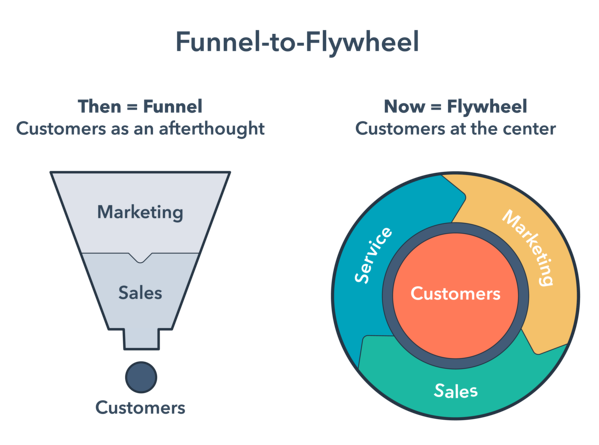Prices on advertising platforms such as Google and Facebook for customer acquisition have risen sharply in recent years. Instead of always buying new customers at a high price, the focus is on earning more from existing customers or converting them into loyal brand ambassadors. And for that, you need the Flywheel.
Any company, can sustain growth and increase Customer Lifetime Value (CLV) with the expanded Flywheel concept.
Where does this term come from?
Generally, a flywheel is made of a heavy material. Once it is set in rotation, it slows down its run only leisurely. The more energy a flywheel gains, the faster it spins. After that, only a little energy is needed to keep the wheel moving.
The Flywheel uses this effect to drive customer acquisition. In the long term, these impulses develop a momentum of their own to generate leads, demand and sales. And also increase trust and brand awareness.
Who invented the Flywheel?
Management expert Jim Collins developed the concept for the Flywheel in 2001. At a later stage, he developed it further together with Amazon founder Jeff Bezos. The focus of the flywheel was growth.

The positive customer experience serves to set growth in motion. This increases the number of visitors. This makes Amazon interesting for external merchants. With more merchants and their offers, the assortment grows. A larger assortment improves the customer experience. With such additional growth, Amazon can lower its own costs and thus the price for customers. These measures pay off in terms of customer experience.
Amazon builds on the concept of the virtuous circle, which is focused on the customer. This idea was sketched out on a napkin by CEO Jeff Bezos back in the day, and it remains an ever-present, vibrant part of Amazon’s culture. (Legend)
Hubspot founder and CEO Brian Halligan has applied the concept of the flywheel to marketing. In a 2018 guest article for Harvard Business Review, he declaimed that the concept of the sales funnel has had its day and needs to be replaced by the flywheel.
Flywheel vs. Sales Funnel
The classic sales funnel is structured like a funnel. After passing through the individual phases, the paying customer is at the end. At this point, the process is mentally complete.
As a result, enormous potential is lost and a lot of energy has been expended (expenditure/time). This cycle in the form of the new customer repeats itself again and again. It lacks ideas, how the content customer recommends the enterprise or product further. Why does nobody think about how already existing customers can be “instrumentalized” for the further growth and concrete conclusions in the positive sense?
At Flywheel, the customer is always at the center of all activities. To ensure that there is no standstill, the Sales, Marketing and Service departments keep the wheel in constant motion. Even when the customer has officially completed the customer journey, the wheel continues to turn around him.

Brian Halligan recognizes with the use of the funnel the motivation of companies to have the best possible product. Recently, the goals have changed that now customer satisfaction is paramount. Therefore, with the Flywheel, service is also included.
How does the model work?
Three factors influence the dynamics of the circuit model:
- Velocity
- Friction
- Size
The most successful companies pay strategic attention to all three factors. This can be achieved through additional investments in specific departments. Strengthening customer satisfaction particularly creates momentum, e.g., through inbound marketing campaigns, freemium offers, or a customer referral program.
By amplifying the dynamics of the cycle, there are counteracting forces (friction). These must be eliminated from the strategy as best as possible. Friction losses are all factors that slow down the dynamics of a cycle, e.g. inefficient processes, lack of team communication or neglect of customer needs. Therefore, analyze your team structures, why customers churn and at what points the purchase is abandoned. Is pricing straightforward or full of confusing fees and extras? Can your customers contact you easily? The more velocity is increased and friction is decreased, the more brand ambassadors are gained. And these add further momentum to the cycle.
Inbound and the Flywheel
Applying the circular model to the inbound methodology results in a cycle of three phases and creates a delightful customer experience
- Dress
- Interact
- Inspire
The first phase, Attract, is about attracting customers with interesting, helpful content and making sure they can access all the information they need easily and quickly. It is much more effective for companies not to impose themselves on customers, but to ensure that they become aware of their own accord. Search engine optimization SEO), content marketing and conversion rate optimization are factors that you use to bring momentum into the cycle.
The goal of the second phase, Interact, is to make the buying process as pleasant and straightforward as possible by giving prospects the opportunity to interact with companies through their preferred channels and at times that suit them. This is the cornerstone of long-term relationships. Website and email personalization, automation, and multi-channel communications add momentum here.
The third phase, delight, is about providing the best possible support to customers and helping them achieve their goals. The dynamic drivers are self-service (knowledge base, chatbot), customer surveys and customer loyalty programs.
Satisfied customers are the key to effective, sustainable growth.
The circular model reduces cumbersome handoffs between different teams. Thanks to the Flywheel, each team is responsible for engaging, interacting with, and delighting customers. You deliver a consistent, seamless, and positive experience to your customers.
I recommend HubSpot’s article How the Flywheel Killed HubSpot’s Funnel for more infomation.

